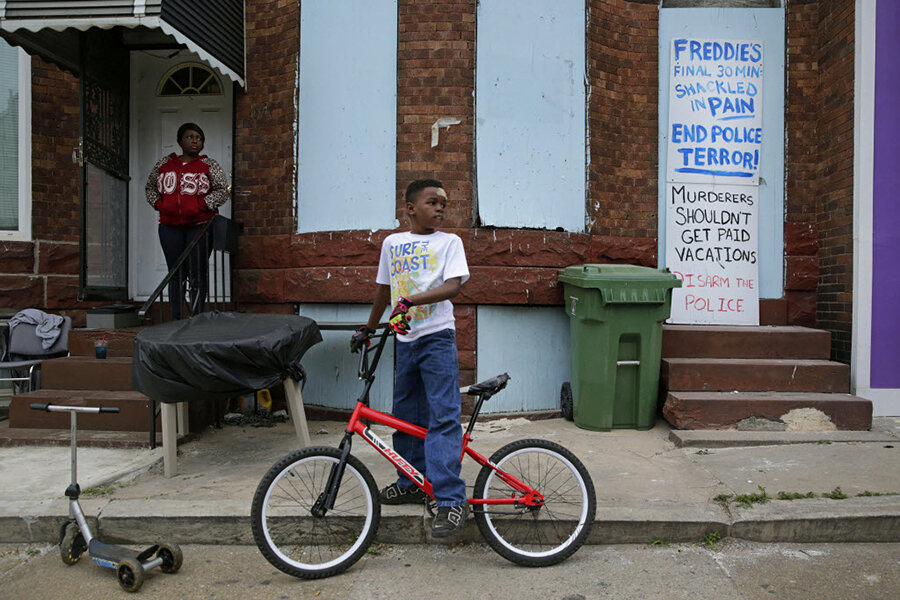Baltimore police shoot teen with fake gun: Does that happen often?
Baltimore police shot a teenage boy on Wednesday afternoon who was carrying a fake gun, in a case that brought echoes of the shooting of 12-year-old Tamir Rice in a Cleveland park two years ago.
The boy suffered what police said were non life-threatening injuries to a “lower extremity,” the Baltimore Sun reports. Police Commissioner Kevin Davis declined to identify the boy, who he said was 13, and said he believed officers had acted appropriately. He is expected to recover, police say.
His mother, Volanda Young, identified him as 14-year-old Dedric Colvin, telling the Sun her son was shot once in the shoulder and once in the leg. She learned of the shooting from her older son, Alvin, and ran outside to discover her son bleeding on the ground, she told the paper.
This shooting, which came on the one-year anniversary of the funeral of Freddie Gray and protests following his death, once more highlights a lack of data. While there have been several incidents of police using force on suspects carrying toy guns and attempts to crack down on the sales of realistic-looking replicas, the most complete national data on how often such incidents occur is more than 25 years old.
“Scant data exist on the incidence of crimes, injuries, or deaths involving toy guns and on the long-term effects that childhood play with toy guns may have on individuals,” the Government Accountability Office wrote to then-Rep. Edolphus Towns (D) of Brooklyn in 2003, noting that the most comprehensive national study, conducted by the Police Executive Research Forum (PERF), involved data from 1985 to 1989.
Representative Towns introduced a bill to ban toy guns entirely in New York in January 2003. Baltimore already bans the sale of air rifles and BB guns to minors.
On Wednesday, Commissioner Davis acknowledged the significance of the date. “It’s not lost on me what 27 April means to this city, means to this police department, what it means to me personally," he said.
On April 12, 2015, Mr. Gray, who was black, suffered a fatal spinal injury in police custody. After his funeral on April 27, two weeks of mostly peaceful protests took a darker turn as incidents of violence and vandalism quickly caused millions of dollars of damage and left dozens of civilians and police officers injured.
The shooting on Wednesday occurred about 4 p.m., after two plainclothes detectives spotted the boy carrying what they believed to be a firearm, Davis said.
The detectives then got out of their vehicle, identified themselves as officers, and told him to stop, Davis told reporters. After the boy began running, the officers chased him for about 150 yards and one detective shot the boy, he said.
Police released a photograph of the gun they said the boy was carrying, which Davis said was very difficult to distinguish from a real firearm.
“It's an absolute, identical replica semiautomatic pistol. Those police officers had no way of knowing that it was not, in fact, an actual firearm. It looks like a firearm,” Davis said.
Ms. Young, the boy’s mother, told the Sun that officers handcuffed her after she attempted to leave to call Johns Hopkins Hospital, where her son had been taken. “Is my son alive?” she said she pleaded with police.
She was then taken to a police station and questioned and briefly put in a cell. “It was humiliating,” she told the paper, saying she eventually prevailed on officers to take her to the hospital after two hours.
“He gets good grades. My son is a good kid,” Young told the paper. “I know he was scared. They shot at him while he was fleeing.” She said she didn’t know how her son had obtained the BB gun.
The incident had parallels to Tamir’s death in Cleveland, where video showed that police had handcuffed his 14-year-old sister as he lay dying. The county prosecutor declined to charge the officer who shot Tamir, though the city of Cleveland recently settled a federal lawsuit brought by his family for $6 million.
In comments criticized by attorneys for the Rice family, the head of Cleveland’s Police Patrolman’s Association said Tuesday that some of the funds should be used to “educat[e] youth of the dangers of possessing a real or replica firearm.”
Are police shootings of people with toy guns unusual?
According to the PERF report, 31 law enforcement agencies reported 105 incidents involving the use of force (including deadly force) where a suspect had a toy gun over a five-year span. The report didn’t specify how many of the incidents resulted in injuries or deaths, the GAO noted in 2003.
During that period, 148 law enforcement agencies reported that there were 2,796 robberies committed with toy guns and 3,104 assaults, while law enforcement agencies had seized 10,065 guns.
While there were many more incidents involving real firearms, the researchers noted, “many of the confrontations between police officers and persons with toy guns seem to have unusually tragic elements.”
In November 2015, the Justice Department began tracking citizens’ complaints about officers’ use of force as part of its crime statistics.
In Baltimore, Davis said investigators would look into the circumstances surrounding the boy’s shooting, including whether he aimed the BB gun at detectives and how many times they fired, the Sun reports.
“No police officer in Baltimore wants to shoot a 13-year-old, but police officers here and elsewhere are charged by us, by our community, with going after bad guys with guns,” he said.
He said he had he believed the officers had acted appropriately, but added, “Investigating police-involved shootings is a sacred obligation to this police department. We're going to get it right.”





